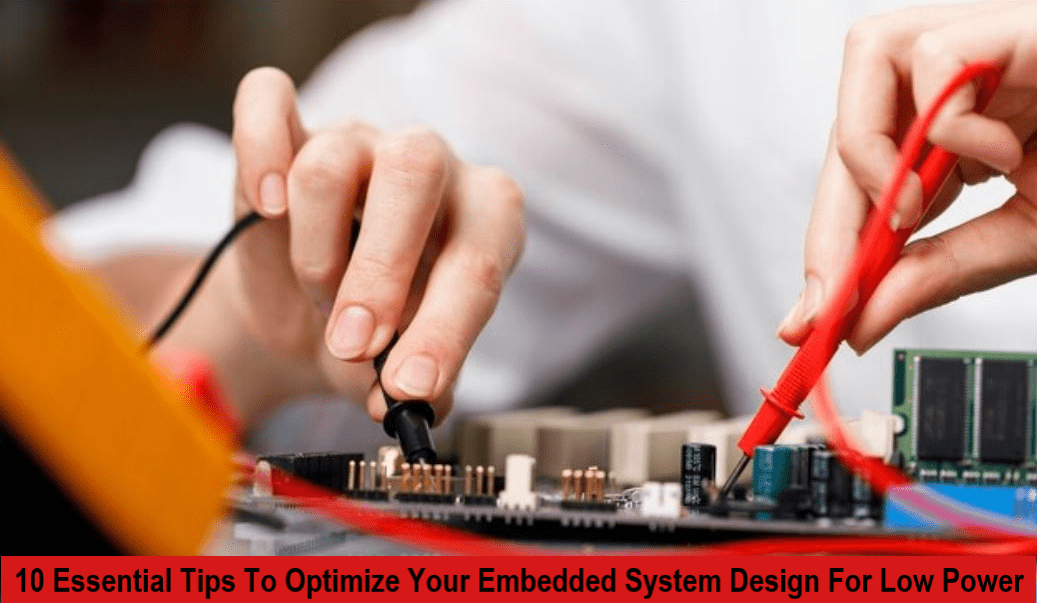
In the development of embedded devices running on low power or micro application of IOT like smart watch or a smart switch, which requires low power or very low power, optimizing embedded systems for managing low power consumption becomes a main concern. Whether you're developing devices for IoT applications or designing intricate electronics, achieving energy efficiency is key. In this blog post, we'll explore 10 important tips to help you optimize your embedded system design for low power, ensuring enhanced performance and long duration battery life.
Focus on The Following Important Elements For Low Power Embedded System Design
Selecting Energy-Efficient Components
If you are going to build a low-power design in your device, you should carefully choose components that have low power consumption. You should always select microcontrollers, sensors, and other peripheral components that offer the best balance between performance and energy efficiency. This step in the start of building any Embedded device will ensure your application to be made for low power operation.
Utilize Low-Power Microcontrollers
You should always choose a microcontroller which is specifically designed for low-power applications. The chips like ESP32, ESP8266, Nuvoton MCUs, often come equipped with various power-saving modes, enabling you to build power consumption based on system requirements.
Implement Effective Power Management Strategies
One should always try to Develop robust power management strategies to dynamically adjust power levels based on system demand. Employ techniques such as voltage scaling, clock gating, and sleep modes to reduce power consumption when the device is in idle state. If you can manage on-circuit supply and give a way to efficiently deliver power to each component in your circuit then the device will work efficiently for a long duration.
Optimize Code for Efficiency
Write efficiently and optimize your embedded code. The code should minimize the workload on the processor so it should not burn out while carrying out multiple processes. Not properly managed code will generate extra workload on the processor which will take more power than required. Eliminate unnecessary loops, reduce code execution time, and implement sleep modes to enhance overall system efficiency.
Efficient Use of Sleep Modes
You should set up a wake up event and mostly try to put your MCU in sleep mode. Leverage sleep modes in your code to place inactive components in low-power states. Configuring wake-up mechanisms to ensure the system seamlessly transitions between sleep and active modes, reducing overall energy consumption. Many controllers for eg. ESP32 comes with a sleep mode, where in idle state the device enters sleep mode resulting in 0 power consumption and whenever any external information it receives it will wake up.
Choose the Right Communication Protocols
Choosing a right communication Protocol is very important in making a Low power Embedded system design. Communication protocols such as SPI, UART, I2C, MODBUS, etc, have different power characteristics. Selecting communication protocols wisely to ensure minimal power consumption during data transmission. Protocols like MQTT for IoT devices, which minimize the time radio modules spend in active mode, can significantly contribute to power savings.
Optimize Sensor Readings
Fine-tune the sensor readings to collect data only when necessary. Implementing code/algorithm logic to trigger sensor readings based only on specific events or thresholds, reducing the frequency of data acquisition and minimizing power usage is must to integrate to efficiently working of low power operation.
Efficient Power Supplies
Selection of external power supplies is crucial in making a low power embedded system design. You should choose power supplies that align with your low-power goals. Switch to switching regulators instead of linear regulators, as they are more energy-efficient, they convert excess voltage into usable power without dissipating excess energy as heat.
Thermal Management
Implementing effective thermal management to prevent overheating, which can adversely affect power efficiency. Using proper heat sinks, ventilation, and temperature monitoring to ensure the system operates optimally without consuming excess power to cool itself down. You should design the outer covering of the device well so that the air flow should happen freely to avoid overheating of the device.
Continuous Testing and Optimization and Validation
Regularly test and optimize your embedded system design for low power throughout the development process. Evaluate the impact of design changes on power consumption and make adjustments accordingly, ensuring constant improvement.
The low power device should get rigorously tested under various conditions to ensure it meets power efficiency goals without compromising performance and reliability. Validate power consumption at different states to identify potential areas for improvement.
Conclusion
You should definitely follow these 10 important tips to optimize your embedded system design for low power. By incorporating these 10 tips into your embedded system design process, you can significantly enhance power efficiency, long battery life, and build a more sustainable and reliable product. You should Keep in mind that the key to build a low power embedded system design lies in both theoretical and practical approach to optimization, where continuous testing and refinement lead to an embedded system that excels in low-power performance.
For any low power embedded product to function optimally in the field, thorough testing in a real environment or under simulated stress conditions is essential. When assessing your low-power embedded system, ensure the simulation of relevant scenarios. Campus Component offers a comprehensive selection of electronic components online for your low power design and construction processes, providing quality assurance at competitive prices.

